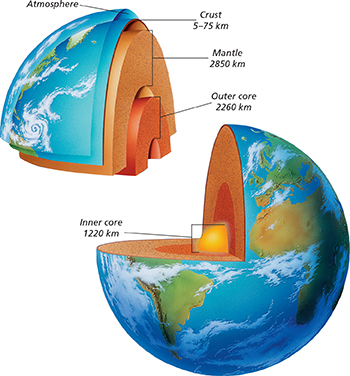The Mantle
Beneath the crust is the mantle, a thick layer of hot but solid rock. As Figure 4 shows, the mantle extends about 2850 kilometers, from beneath the crust to the top of the core. Both pressure and temperature increase tremendously the deeper you go into the mantle. Like the crust, the mantle is composed mainly of silicates. The mantle is rich in iron and magnesium, and so is denser throughout than the crust.
Geologists divide the mantle into three layers based on the physical properties of the rock. The lithosphere (LITH uh sfeer) is a layer of relatively cool, rigid rock that includes the uppermost part of the mantle as well as Earth's crust. On average, the lithosphere measures about 100 kilometers thick, although it is thicker below the continents and thinner beneath the oceans. Beneath the lithosphere in the mantle is the asthenosphere (as THEN uh sfeer), a layer of softer, weaker rock that can flow slowly, the way taffy does. Beneath the asthenosphere is the stronger lower part of the mantle called the mesosphere. The stiffer rock of the mesosphere extends all the way down to the upper surface of Earth's core.

What is the asthenosphere?
Figure 4 Earth's interior is composed of three main layers—the crust, the mantle, and the core. Earth's rocky crust is its thinnest layer. Most of the interior is occupied by the hot, solid mantle, the molten metal outer core, and the solid metal inner core.
Interpreting Diagrams Which layer is thickest, the crust, mantle, or outer core?
 d
d




